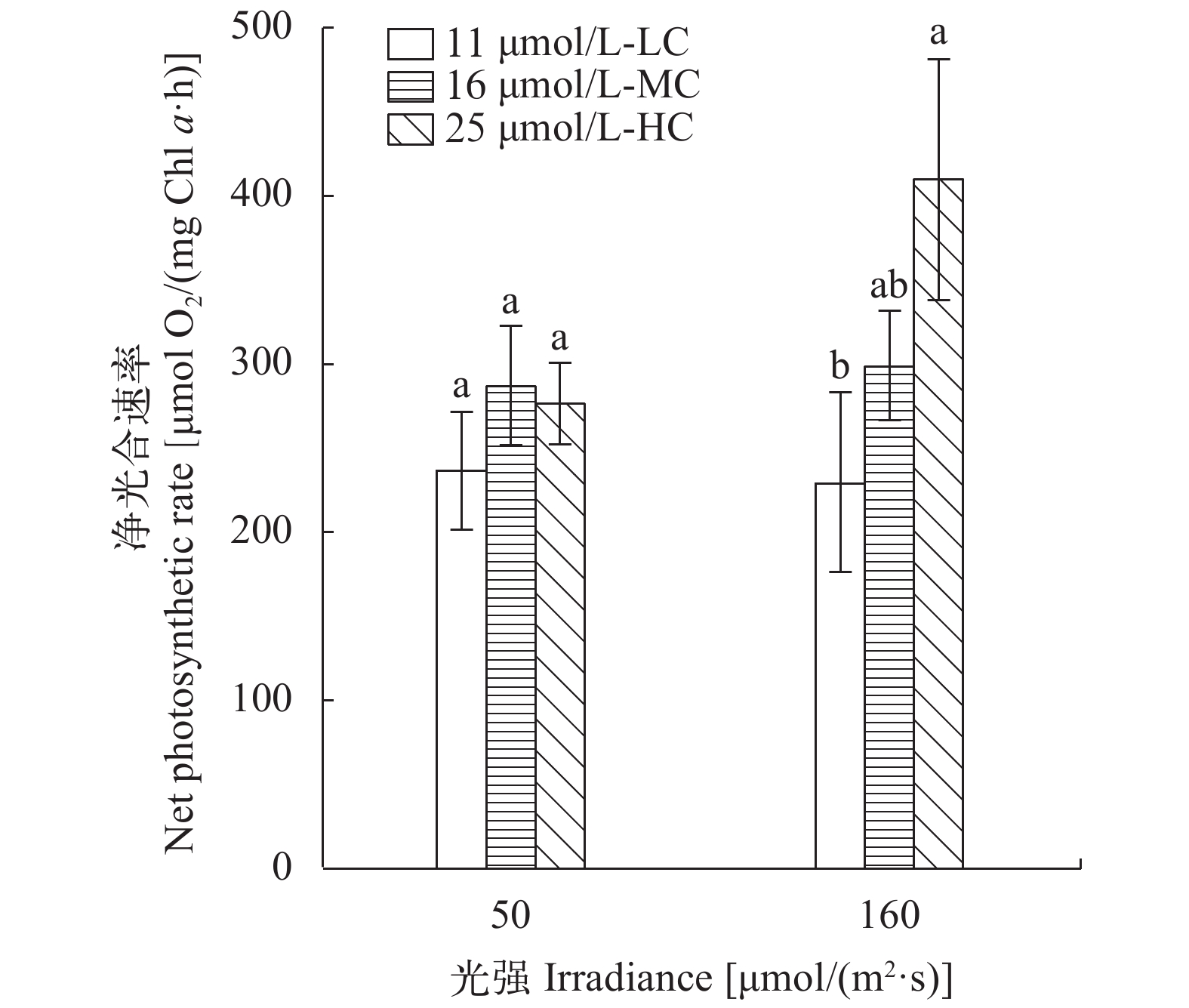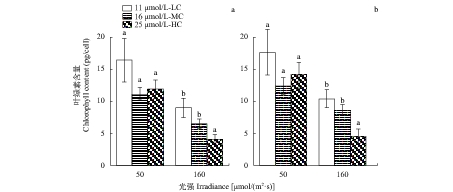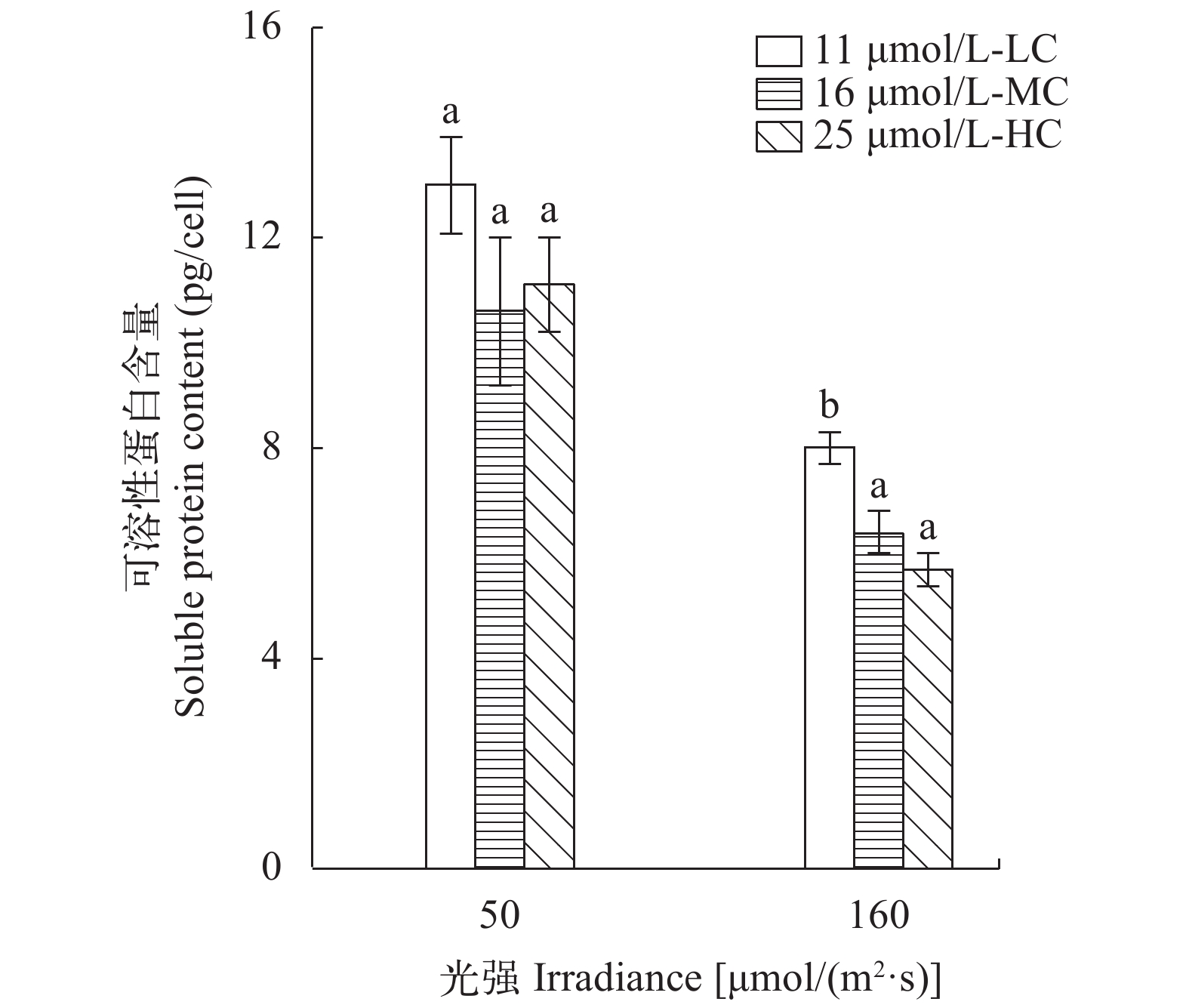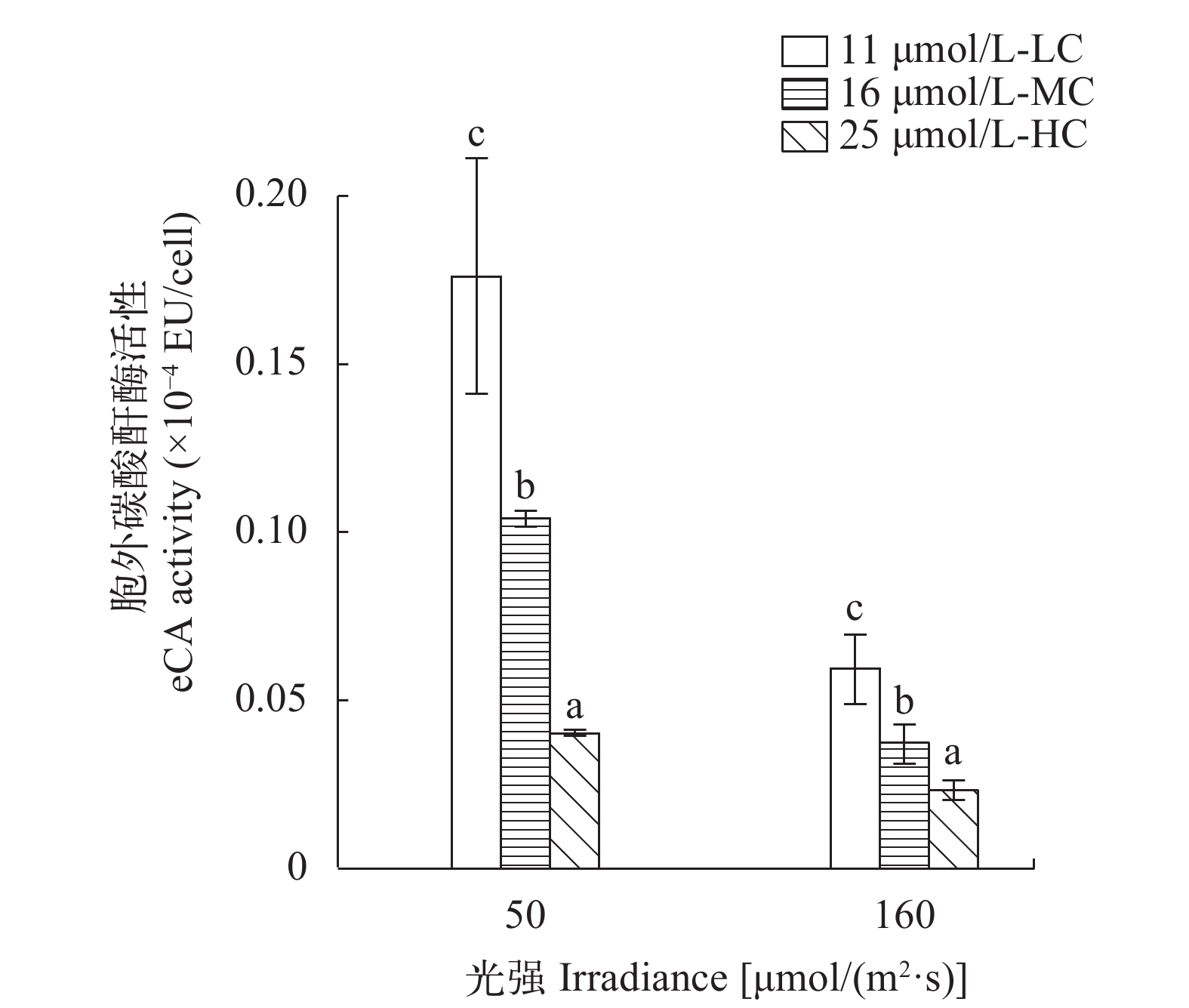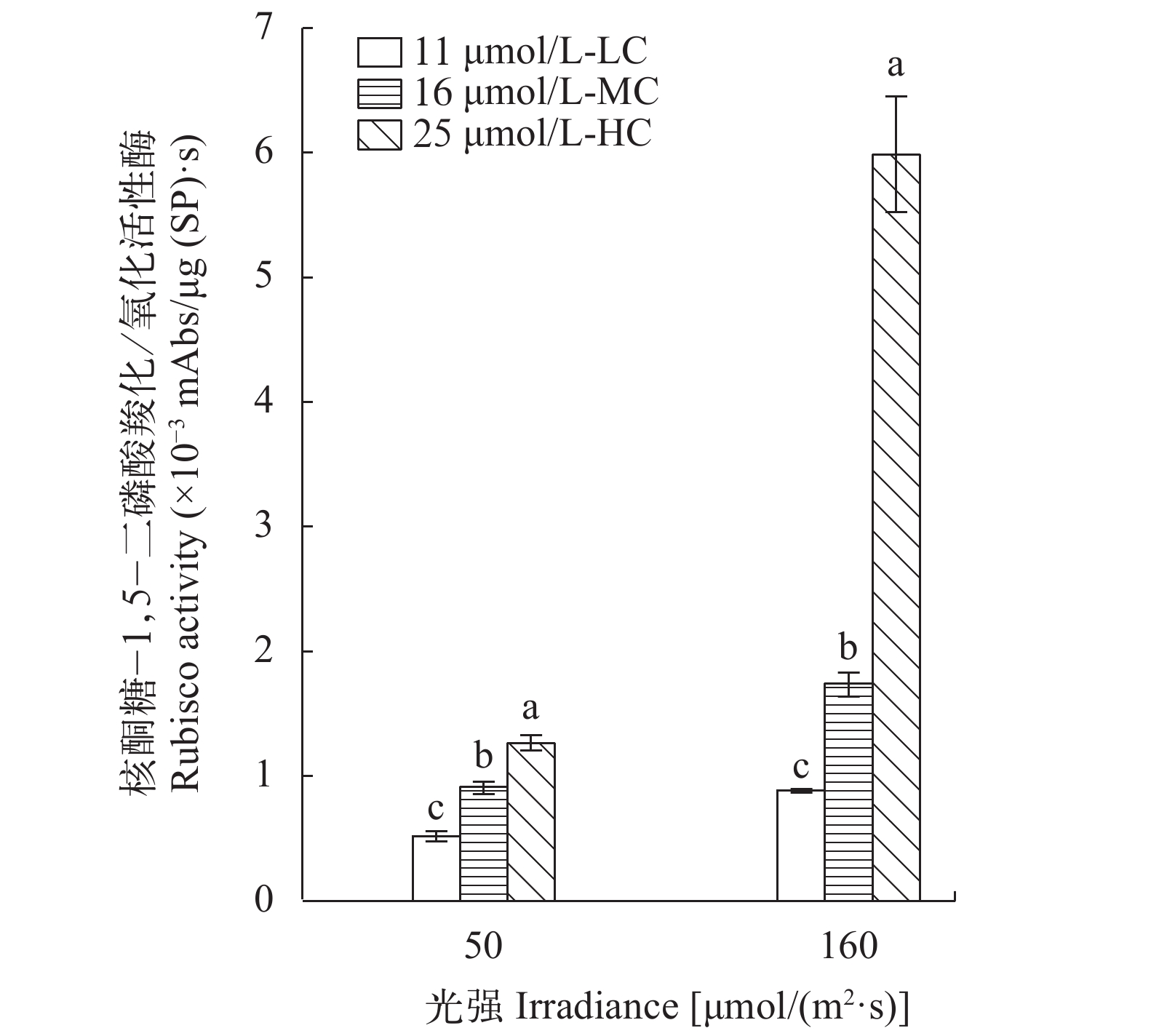LIGHT-MODULATED PHYSIOLOGICAL RESPONSE TO OCEAN ACIDIFICATION IN PHAEODACTYLUM TRICORNUTUM
-
摘要: 光和海洋酸化(CO2浓度升高)分别对海洋硅藻的光合能力具有不同程度的影响, 但两者的耦合响应被较少关注。研究以三角褐指藻作为实验材料, 测定了不同光强下CO2浓度升高对三角褐指藻的生长、净光合速率、生化组分、胞外碳酸酐酶(eCA)活性和核酮糖-1,5-二磷酸羧化/氧化酶(Rubisco)活性的影响。结果显示在低光下, CO2浓度对三角褐指藻的生长和净光合速率(Pn)并没有显著影响, 而在高光下, 具有明显的影响。无论是在高光或是低光下, eCA活性、叶绿素和可溶性蛋白的含量都随着CO2浓度的升高而降低。在低光下, 高浓度CO2 (HC)培养下的Rubisco活性分别是低浓度CO2 (LC)和中浓度CO2 (MC)的2.42和1.39倍, 而在高光下, HC培养下的Rubisco活性分别是LC和MC的6.72和3.45倍。以上结果表明硅藻能够通过调节光合生理特征和CCM运行中能量的分配来适应环境中光强和CO2浓度的变化。
-
关键词:
- 光强 /
- 海洋酸化 /
- 三角褐指藻 /
- 碳酸酐酶 /
- 核酮糖-1,5-二磷酸羧化酶/氧化酶
Abstract: There is increasing evidence that different light intensities or ocean acidification (OA) induced by elevated atmospheric CO2 concentration can affect the photosynthetic capacity of marine diatom to different degrees, respectively however, little attention had been paid to their interaction on diatom. In this study, the growth rate, net photosynthetic rate (Pn), biochemical composition, extracellular carbonic anhydrase (eCA) activity, and Ribulose-1,5-bisphosphate carboxylase/oxygenase (RubiscO) activity were investigated when Phaeodactylum tricornutum was grown under different light intensities and CO2 concentrations. The results showed that the specific growth rates and Pn in P. tricornutum were not significantly affected by CO2 concentration under low light intensity (LL), whereas in presence of the high light intensity (HL), elevated CO2 concentration was beneficial to promote the increase of the rate of Pn. The eCA activity, chlorophyll content, and soluble protein content decreased with increase of CO2 concentration, regardless of the high or low light. Under LL, RubiscO activity of HC-grown algae was 2.42 and 1.39 times higher than that of LC- or Medium-CO2 (MC)-grown ones. However, RubiscO activity of HC-grown algae was 6.72 and 3.45 times greater than that of LC- or MC-grown ones under high light. These results indicate that the algae can adapt to changes of light intensity and CO2 concentrations in the environment by adjusting the allocation of energy during the operation of the CO2-concentrating mechanism and photosynthesis. -
This page contains the following errors:
error on line 1 at column 1: Start tag expected, '<' not foundBelow is a rendering of the page up to the first error.
硅藻CCMs的运行是个耗能的过程, 其活性不仅取决于外部无机碳(Inorganic carbon, Ci)浓度, 还与光能的获取有着密切的联系[5, 18]。藻类的光合作用为Ci的转运提供能量, 对CCMs的活性具有直接的影响[19—21]。光和CO2浓度是2个重要的环境因子, 其对藻类的相互作用会影响藻类的光合生理和海洋生态环境[22]。在酸化和200 μmol photons/(m2·s)的光强下, 三角褐指藻能够减少CCMs运行过程中的能量支出, 并将这部分能量用于细胞的增长[16]。此外, CO2和光强的交互作用还会对浮游植物群落造成影响。当CO2浓度升高时, 低光强能够促进浮游植物群落的生长和碳的固定, 而在高光强下浮游植物群落初级生产力下降[23]。光和CO2对藻的生长和光合特性的影响是存在差异的, 涉及藻类对光和海洋酸化的响应机制还需要进一步探索[15, 22]。
本文利用海洋浮游硅藻的模式藻种三角褐指藻作为实验材料, 通过测定不同光强和CO2浓度下三角褐指藻光合生理、碳酸酐酶(Carbonic anhydrase, CA)和Rubisco活性的变化, 探讨光强和CO2浓度对于三角褐指藻CCM的调节作用。
1. 材料与方法
三角褐指藻bac-2 (Phaeodactylum tricornutum
Bohlin)取自中国科学院海洋研究所。藻细胞被培养在f/2加富的天然海水中, 温度为(20±1)℃, 设置高、低光的光强分别为160和50 μmol photos/(m2·s), 培养液的pH分别控制在7.80±0.05、8.00±0.05和8.20±0.05, 相当于CO2浓度分别为25 μmol/L (High carbon dioxide concentration, HC)、16 μmol/L (Medium carbon dioxide concentration, MC)和11 μmol/L (Low carbon dioxide concentration, LC)。三角褐指藻的接种起始密度为500 cell/mL, 通过添加饱和CO2海水以维持培养液中pH。培养至18—20代后用0.45 μm聚酰胺滤纸过滤收集用于实验。 1.1 海水碳酸盐化学
通过滴定法测定海水[温度: (20±1)℃; 盐度:30‰]的总碱度(Total alkalinity, TA)[24, 25]。通过TA、pH和硼酸浓度计算培养液中的碳酸碱度[26], CO2的浓度通过碳酸碱度计算获得[27]。
1.2 生长测定
用血球计数板在显微镜下对藻细胞进行计数。比生长速率(Specific growth rate, SGR)通过以下公式计算: μ=(lnX2–lnX1)/(T2–T1), 其中, X1和X2分别代表三角褐指藻在T1和T2时的细胞密度。
1.3 光合作用测定
采用Clark型氧电极(YSI 5300A, YSI, USA)在400 μmol photons/(m2·s)的光强下测定藻细胞的净光合放氧速率。用恒温循环水浴连接反应槽, 使反应槽中的温度维持在(20±0.1)℃, 测定过程中三角褐指藻的细胞密度约为6.0×106 cell/mL。
1.4 可溶性蛋白含量测定
用考马斯亮蓝G-250染料结合法测定可溶性蛋白(Soluble protein, SP)含量 [28]。将培养样品在4℃, 12000×g的条件下离心3min收集藻细胞。在收集的藻细胞中加入5 mL的蒸馏水, 然后用超声波细胞破碎仪破碎藻细胞, 并在5000 r/min下离心10min。取1 mL上清液, 再加入5 mL考马斯亮蓝G-250溶液, 用紫外可见分光光度计(UV-1800, 岛津, 日本)测定其在595 nm处的吸光度, 再用标准曲线计算SP含量。用牛血清蛋白作为标准。
1.5 叶绿素含量测定
通过离心(12000×g, 5min)收集藻细胞, 弃上清液, 加入5 mL 90%的丙酮, 然后在4℃的暗环境中静置12h。提取液在20℃, 5000 r/min的条件下离心10min后, 取上清液, 于紫外可见分光光度计(UV-1800, 岛津, 日本)上测定各波长下的吸光度。根据以下公式计算藻细胞的Chl. a, c含量[29]:
Chl. a (μg/mL)=11.47×A664–0.40×A630
Chl. c (μg/mL)=24.36×A630–3.73×A664
式中, A630和A664分别代表在波长630和664 nm下的吸光度。
1.6 碳酸酐酶活性测定
CA活性用调整后的电量法进行测定[30]。将纯水置于4℃恒温循环水浴中, 通入高纯度CO2气体约60min, 制取CO2饱和水。将反应槽连接在恒温水浴循环器上, 使反应槽中的温度维持在4℃。取5 mL含藻细胞(6.0×106 cell/mL)的巴比妥溶液(20 mmol/L, pHnbs 8.3)置于反应槽中, 然后加入4 mL的CO2饱和水(4℃)测定pHnbs 8.3降至pHnbs 7.3所需的时间。CA活性通过以下公式测定: Units CA=10×(T0/T–1), 其中, T0和T分别表示不存在和存在酶的情况下pH从8.3下降到7.3所需的时间。
1.7 Rubisco活性测定
Rubisco活性测定参照Helbling等[31]的方法。离心收集藻细胞后, 将酶粗提取液加入到离心管中, 摇匀后将细胞置于4℃的冷水浴中用超声波进行破碎, 然后在12000×g, 4℃下离心15min, 取上清液。酶粗提的缓冲溶液(pHnbs8.00)包含50.00 mmol/L Tril-HCl、20.00 mmol/L MgCl2、0.20 mmol/L EDTA (Ethy-lenediaminetetraacetic acid, EDTA)和5.00 mmol/L Glutathione。Rubisco活性测定混合溶液(pHnbs8.00)中包含0.20 mmol/L还原性辅酶Ⅰ(Nicotinamide adenine dinucleotide, NADH)、3.00 mmol/L ATP (Adenosine triphosphate, ATP)、5.00 mmol/L磷酸肌酸(Phosphatecreatine, CP)、25.00 mmol/L碳酸氢钠(Sodium Bicarbonate, NaHCO3)、22.00 units磷酸肌酸激酶(Creatine phosphokinase, CPK)、18.00 units 3-磷酸甘油磷酸激酶(3-Phosphoglyceric phosphokinase)和9.00 units甘油醛-3-磷酸脱氢酶(Glyceraldehyde-3-phosphate dehydrogenase, GAPDH)。将酶粗提取液加入到Rubisco测定的混合溶液中, 然后用紫外可见分光光度计(UV-1800, 岛津, 日本)在20℃下测定NADH在340 nm下吸光度的变化。藻细胞Rubisco活性以mAbs 340/mg protein·s表示。
1.8 数据分析
应用软件Excel和Origin 8.51进行数据处理与分析, 用单因素方差分析(One-way ANOVA)和Student’s t-test分析不同实验处理间的差异性。直方图上不同字母表示在同一光强下不同浓度CO2处理之间的显著差异, 以P<0.05为差异显著水平。数值表示为平均值± SD,n=3。
2. 结果
2.1 生长
如图 1所示, 在低光强下, 不同的CO2浓度下培养的三角褐指藻比生长速率并没有存在显著的差异(P>0.05); 而在高光强下, HC条件下培养的三角褐指藻比生长速率比MC和LC条件下培养的分别增加了2.20% (P<0.05)和3.2% (P>0.05)。
2.2 净光合速率
在低光强下, 不同浓度CO2下培养的三角褐指藻的净光合速率并无显著差异(P>0.05) (图 2)。而在高光强下培养的三角褐指藻的净光合速率随着CO2浓度的增加而显著升高(P<0.05), 在HC下培养的三角褐指藻的净光合速率分别是在MC和LC下培养的1.37 (P>0.05)和1.78倍(P<0.05) (图 2)。
2.3 叶绿素含量
在低光强下, 不同浓度CO2下培养的三角褐指藻Chl. a和Chl. c含量并无显著差异(P>0.05) (图 3)。在高光强下, LC下培养的Chl. a含量分别是MC和HC下培养的1.38 (P>0.05)和2.17倍(P<0.05); LC下培养的Chl.c含量分别是在MC和HC下培养的1.20 (P>0.05)和2.24倍(P<0.05) (图 3)。
2.4 可溶性蛋白含量
在低光强下, 不同浓度CO2下培养的三角褐指藻可溶性蛋白含量并无显著差异(P>0.05) (图 4)。而在高光强下, MC和HC下培养的可溶性蛋白含量比在LC下培养的分别下降了20.0% (P<0.05)和28.8% (P<0.05) (图 4)。
2.5 碳酸酐酶活性
如图 5所示, 无论在高光强或低光强下, 三角褐指藻的胞外碳酸酐酶(eCA)活性均随CO2浓度升高而降低。在低光强下, MC和HC下培养的细胞其eCA活性分别是LC下培养的59.09% (P<0.05)和22.73% (P<0.05)。在高光强下, MC和HC下培养的eCA活性分别是LC下培养的62.71% (P<0.05)和39.98% (P<0.05) (图 5)。
2.6 Rubisco活性
如图 6所示, 在低光强下, Rubisco活性随CO2浓度增加而升高, 其均值分别为0.52、0.91和1.27×10–3 mAbs/μg(SP)·s, 其中在HC下培养的Rubisco活性分别是LC和MC下培养的2.42 (P<0.05)和1.39倍(P<0.05)。在高光强下Rubisco活性随CO2浓度增加而升高, 其均值分别为0.89、1.74和6.0×10–3 mAbs/μg(SP)·s, 其中HC下培养的Rubisco活性分别是LC和MC下培养的6.72 (P<0.05)和3.45倍(P<0.05)。
3. 讨论
3.1 生长与光合作用
This page contains the following errors:
error on line 1 at column 1: Start tag expected, '<' not foundBelow is a rendering of the page up to the first error.
Sinutok等[36]的研究结果显示, 在光强250 μmol/(m2·s)和海洋酸化条件下Halimeda macroloba和Hali-meda cylindracea的叶绿素含量明显下降, 这与我们的结果是相似的。在低光强下, 藻细胞通过增加叶绿素含量来提高光的捕获能力, 为CCM的运行提供更充足的能量[16]; 而在高光下, 藻细胞通过减少色素含量以达到光保护的目的[37]。此外, 在酸化条件下CCMs活性被削弱, 减少了能量的消耗, 促使藻细胞通过减少叶绿素含量来避免过度的光能吸收以达到光保护的目的[34]。叶绿素和SP的合成需要大量的N, 在低光下, ATP的合成减少, 导致藻细胞对N的同化能力受到限制并影响叶绿素和SP的合成, 从而削弱CO2浓度对叶绿素和SP含量的影响[38]。而在高光强下, CO2浓度的升高导致三角褐指藻SP的含量减少, 这是由于在酸化条件下, 更多的N被用于藻细胞生长过程中的氮代谢和结构同化[39, 40]。
3.2 酶活性
This page contains the following errors:
error on line 1 at column 1: Start tag expected, '<' not foundBelow is a rendering of the page up to the first error.
-
-
[1] Field C B, Behrenfeld M J, Randerson J T, et al. Primary production of the biosphere: integrating terrestrial and oceanic components [J]. Science, 1998, 281(5374): 237—240 doi: 10.1126/science.281.5374.237
[2] Granum E, Raven J A, Leegood R C. How do marine diatoms fix 10 billion tonnes of inorganic carbon per year [J]? Canadian Journal of Botany, 2005, 83(7): 898—908 doi: 10.1139/b05-077
[3] Honjo S, Eglinton T I, Taylor C D, et al. Understanding the role of the biological pump in the global carbon cycle: An imperative for ocean science [J]. Oceanography, 2014, 27(3): 10—16 doi: 10.5670/oceanog
[4] Badger M R, Price G D. The role of carbonic anhydrase in photosynthesis [J]. Annual Review of Plant Physiology Plant Molecular Biology, 1994, 45: 369—392 doi: 10.1146/annurev.pp.45.060194.002101
[5] Badger M R, Andrews T J, Whitney S M, et al. The diversity and co-evolution of Rubisco, plastids, pyrenoids and chloroplast-based CCMs in the algae [J]. Canadian Journal of Botany-revue Canadienne de Botanique, 1998, 76(6): 1052—1071 doi: 10.1139/cjb-76-6-1052
[6] Whitney S P, Baldet P, Hudson G S, et al. Form I Rubiscos from non-green algae are expressed abundantly but not assembled in tobacco chloroplasts [J]. Plant Journal, 2001, 26(5): 535—547 doi: 10.1046/j.1365-313x.2001.01056.x
[7] Burkhardt S, Amoroso G, Riebesell U, et al. CO2 and
${\rm{HCO}}_3^ – $ uptake in diatoms acclimated to different CO2 concentrations [J]. Limnology and Oceanography, 2001, 46(6): 1378—1391 doi: 10.4319/lo.2001.46.6.1378[8] Morel F M M, Cox E H, Kraepiel A M L, et al. Acquisition of inorganic carbon by the marine diatom Thalassiosira weissflogii [J]. Functional Plant Biology, 2002, 29(2): 301—308
[9] IPCC. Climate Change 2014: Synthesis Report. Contribution of Working Groups Ⅰ, Ⅱ and Ⅲ to the Fifth Assessment Report of the Intergovernmental Panel on Climate Change [A]. In: Core Writing Team, Pachauri R K, Meyer L A (Eds.), IPCC, Geneva, Switzerland [C]. 2014, 151
[10] Sabine C L, Feely R A, Gruber N, et al. The oceanic sink for anthropogenic CO2 [J]. Science, 2004, 305(5682): 367—371 doi: 10.1126/science.1097403
[11] Meehl G A, Covey C, Taylor K E, et al. The WCRP CMIP3 multimodel dataset: a new era in climate change research [J]. Bulletin of the American Meteorological Society, 2007, 88(9): 1383—1394 doi: 10.1175/BAMS-88-9-1383
[12] Tortell P D, Payne C D, Li Y, et al. CO2 sensitivity of Southern Ocean phytoplankton [J]. Geophysical Research Letters, 2008, 35(4): 228—236
[13] Reinfelder J R. Carbon concentrating mechanisms in eukaryotic marine phytoplankton [J]. Annual Review Marine Science, 2011, 3(1): 291—315 doi: 10.1146/annurev-marine-120709-142720
[14] Wu Y, Gao K, Riebesell U. CO2-induced seawater acidification affects physiological performance of the marine diatom Phaeodactylum tricornutum [J]. Biogeosciences, 2010, 7(9): 2915—2923
[15] Gao K S, Campbell D A. Photophysiological responses of marine diatoms to elevated CO2 and decreased pH: a review [J]. Functional Plant Biology, 2014, 41(5): 449—459
[16] Li Y H, Xu J T, Gao K S. Light-modulated responses of growth and photosynthetic performance to ocean acidification in the model diatom Phaeodactylum tricornutum [J]. PLoS One, 2014, 9: e96173 doi: 10.1371/journal.pone.0096173
[17] Hopkinson B M, Dupont C L, Allen A E, et al. Efficiency of the CO2-concentrating mechanism of diatoms [J]. Proceedings of the National Academy of Sciences of the United States of America, 2011, 108(10): 3830—3837 doi: 10.1073/pnas.1018062108
[18] Gordillo F J L, Aguilera J, Wiencke C, et al. Ocean acidification modulates the response of two Arctic kelps to ultraviolet radiation [J]. Journal of Plant Physiology, 2015, 173: 41—50 doi: 10.1016/j.jplph.2014.09.008
[19] Giordano M, Beardall J, Raven J A. CO2 concentrating mechanisms in algae: mechanisms, environmental modulation, and evolution [J]. Annual Review of Plant Biology, 2005, 56: 99—131 doi: 10.1146/annurev.arplant.56.032604.144052
[20] Harada H, Nakatsuma D, Ishida M, et al. Regulation of the expression of intracellular β-carbonic anhydrase in response to CO2 and light in the marine diatom Phaeodactylum tricornutum [J]. Plant Physiology, 2005, 139: 1041—1050 doi: 10.1104/pp.105.065185
[21] Ow Y X, Uthicke S, Collier C J. Light levels affect carbon utilisation in tropical seagrass under ocean acidification [J].PLoS One, 2016, 11(3): e0150352 doi: 10.1371/journal.pone.0150352
[22] Gao K S, Helbling E W, Häder D-P, et al. Responses of marine primary producers to interactions between ocean acidification, solar radiation, and warming [J]. Marine Ecology Progress Series, 2012, 470: 167—189 doi: 10.3354/meps10043
[23] Gao K S, Xu J T, Gao G, et al. Rising CO2 and increased light exposure synergistically reduce marine primary productivity [J]. Nature Climate Change, 2012, 2(7): 519—523 doi: 10.1038/nclimate1507
[24] Gran G. Determination of the equivalence point in potentiometric titrations, Ⅱ [M]. Analyst, 1952, 661—671
[25] Millero F J, Zhang J Z, Lee K, et al. Titration alkalinity of seawater [J]. Marine Chemistry, 1993, 44(2-4): 153—165 doi: 10.1016/0304-4203(93)90200-8
[26] Millero F J. Thermodynamics of the carbon dioxide system in the oceans [J]. Geochimica et Cosmochimica Acta, 1995, 59(4): 661—667 doi: 10.1016/0016-7037(94)00354-O
[27] Prieto F J M, Millero F J. The values of pK1+pK2 for the dissociation of carbonic acid in seawater [J]. Geochimica et Cosmochimica Acta, 2002, 66(14): 2529—2540 doi: 10.1016/S0016-7037(02)00855-4
[28] Kochert G. Protein determination by dye binding. In: Hellebust J A, Craigie J S (Eds.), Handbook of Phycological Methods: Physiological and Biochemical Methods [C]., Cambridge, UK: Cambridge University Press. 1978, 92—93
[29] Jeffrey S W, Humphrey G F. New spectrophotometric equations for determining chlorophylls a, b, c1 and c2 in higher plants, algae and natural phytoplankton [J]. Biochemie und Physiologie der Pflanzen, 1975, 167(2): 191—194 doi: 10.1016/S0015-3796(17)30778-3
[30] Wilbur K M, Anderson N G. Electrometric and colorimetric determination of carbonic anhydrase [J]. Journal of Biological Chemistry, 1948, 176(1): 147—154
[31] Helbling E W, Buma A G J, Boelen P, et al. Increase in Rubisco activity and gene expression due to elevated temperature partially counteracts ultraviolet radiation-induced photoinhibition in the marine diatom Thalassiosira weissflogii [J]. Limnology and Oceanography, 2011, 56(4): 1330—1342 doi: 10.4319/lo.2011.56.4.1330
[32] Wu Y P, Campbell D A, Irwin A J, et al. Ocean acidification enhances the growth rate of larger diatoms [J]. Limnology and Oceanography, 2014, 59(3): 1027—1034 doi: 10.4319/lo.2014.59.3.1027
[33] Beardall J, Giordano M. Ecological implications of microalgal and cyanobacterial CO2 concentrating mechanisms and their regulation [J]. Functional Plant Biology, 2002, 29(2-3): 335—347
[34] Schwarz A M, Bjork M, Buluda T, et al. Photosynthetic utilisation of carbon and light by two tropical seagrass species as measured in situ [J]. Marine Biology, 2000, 137(5-6): 755—761 doi: 10.1007/s002270000433
[35] Wu Y, Gao K, Riebesell U. CO2-induced seawater acidification affects physiological performance of the marine diatom Phaeodactylum tricornutum [J]. Biogeosciences, 2010, 7(9): 2915—2923 doi: 10.5194/bg-7-2915-2010
[36] Sinutok S, Hill R, Doblin M A, et al. Microenvironmental changes support evidence of photosynthesis and calcification inhibition in Halimeda under ocean acidification and warming [J]. Coral Reefs, 2012, 31(4): 1201—1213 doi: 10.1007/s00338-012-0952-6
[37] Gordillo F J L, Figueroa F L, Niell F X. Photon- and carbon-use efficiency in Ulva rigida at different CO2 and N levels [J]. Planta, 2003, 218(3): 315—322
[38] Trimborna S, Thomsa S, Brenneisa T, et al. Two Southern Ocean diatoms are more sensitive to ocean acidification and changes in irradiance than the prymnesiophyte Phaeocystis Antarctica [J]. Physiologia Plantarum, 2017, 160: 155—170 doi: 10.1111/ppl.2017.160.issue-2
[39] Andría J, Vergara J, Perez-Llorens J L. Biochemical responses and photosynthetic performance of Gracilaria sp. (Rhodophyta) from Cádiz, Spain, cultured under different inorganic carbon nitrogen levels [J]. European Journal of Phycology, 1999, 34(4): 497—504
[40] Chen B B, Zou D H, Ma J H. Interactive effects of elevated CO2 and nitrogen- phosphorus supply on the physiological properties of Pyropia haitanensis (Bangiales, Rhodophyta) [J]. Journal Applied Phycology, 2016, 28(2): 1235—1243 doi: 10.1007/s10811-015-0628-z
[41] Martin C L, Tortell P D. Bicarbonate transport and extracellular carbonic anhydrase activity in Bering Sea phytoplankton assemblages: Results from isotope disequilibrium experiments [J]. Limnology and Oceanography, 2006, 51(5): 2111—2121 doi: 10.4319/lo.2006.51.5.2111
[42] Swarnalatha G V, Hegde N S, Chauhan V S, et al. The effect of carbon dioxide rich environment on carbonic anhydrase activity, growth and metabolite production in indigenous freshwater microalgae [J]. Algal Research, 2015, 9: 151—159 doi: 10.1016/j.algal.2015.02.014
[43] Machler F, Nosberger J. Regulation of ribulose bisphosphate carboxylase activity in intact wheat leaves by light, CO2, and temperature [J]. Journal of Experimental Botany, 1980, 31(125): 1485—1491
[44] Fouilland E, Courties C, Ddescolas-Gros C. Size-fractionated phytoplankton carboxylase activities in the Indian sector of the Southern Ocean [J]. Journal of Plankton Research, 2000, 22(6): 1185—1201 doi: 10.1093/plankt/22.6.1185
[45] Ihnken S, Eggert A, Beardall J. Exposure times in rapid light curves affect photosynthetic parameters in algae [J]. Aquatic Botany, 2010, 93(3): 185—194 doi: 10.1016/j.aquabot.2010.07.002
[46] Wu S C, Huang A Y, Zhang B Y, et al. Enzyme activity highlights the importance of the oxidative pentose phosphate pathway in lipid accumulation and growth of Phaeodactylum tricornutum under CO2 concentration [J]. Biotechnology for Biofuels, 2015, 8(1): 1—11 doi: 10.1186/s13068-014-0179-6
[47] Raven J A. Physiology of inorganic C acquisition and implication for resource use efficiency by marine phytoplankton: relation to increased CO2 and temperature [J]. Plant, Cell & Environment, 1991, 14(8): 779—794
-
期刊类型引用(7)
1. 赵璐,钟志海,杨剑超,顾成柏. 海洋酸化和铜离子对三角褐指藻生长和光合活性的影响. 海洋湖沼通报(中英文). 2025(01): 88-95 .  百度学术
百度学术
2. 林昕,陈曦贝,石哲萱,王宏伟. 海洋微藻碳酸酐酶研究进展. 厦门大学学报(自然科学版). 2023(03): 325-337 .  百度学术
百度学术
3. 胡子恒. 海水酸化和升温对三角褐指藻光合和呼吸的影响. 生物化工. 2023(06): 125-128 .  百度学术
百度学术
4. 舒明雨,龚一富,吕欣梦,贾泽茗,王博,刘瑄瑄,王何瑜. 三角褐指藻dxs基因克隆与诱导表达. 水生生物学报. 2022(09): 1310-1318 .  本站查看
本站查看
5. 吴思滢,黄炳耀,潘东进,岑英,余林婵,姚绍嫦. 外源一氧化氮调控三角褐指藻响应氮胁迫的作用研究. 广西科学. 2022(05): 863-870 .  百度学术
百度学术
6. 叶鑫,虞新磊,胡朝阳,徐年军,孙雪. CO_2和乙酸钠对雨生红球藻生长及其虾青素积累的影响. 核农学报. 2021(03): 613-622 .  百度学术
百度学术
7. 张莺脐,张羡宇,石硕,刘佩武,张倩,刘鹰,郭睿. 球等鞭金藻对氟苯尼考胁迫的响应研究. 水生生物学报. 2020(06): 1278-1286 .  本站查看
本站查看
其他类型引用(6)



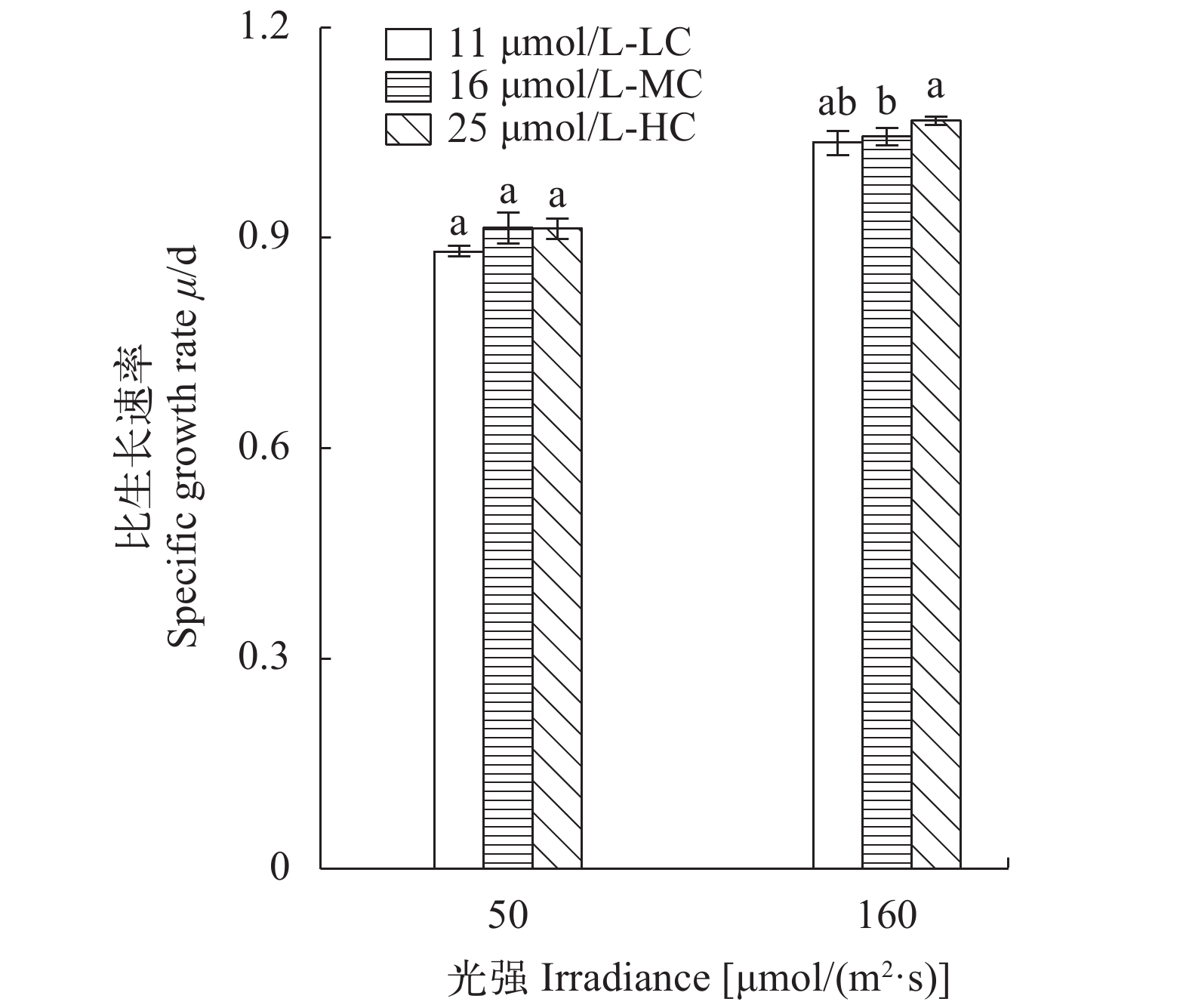
 下载:
下载:
